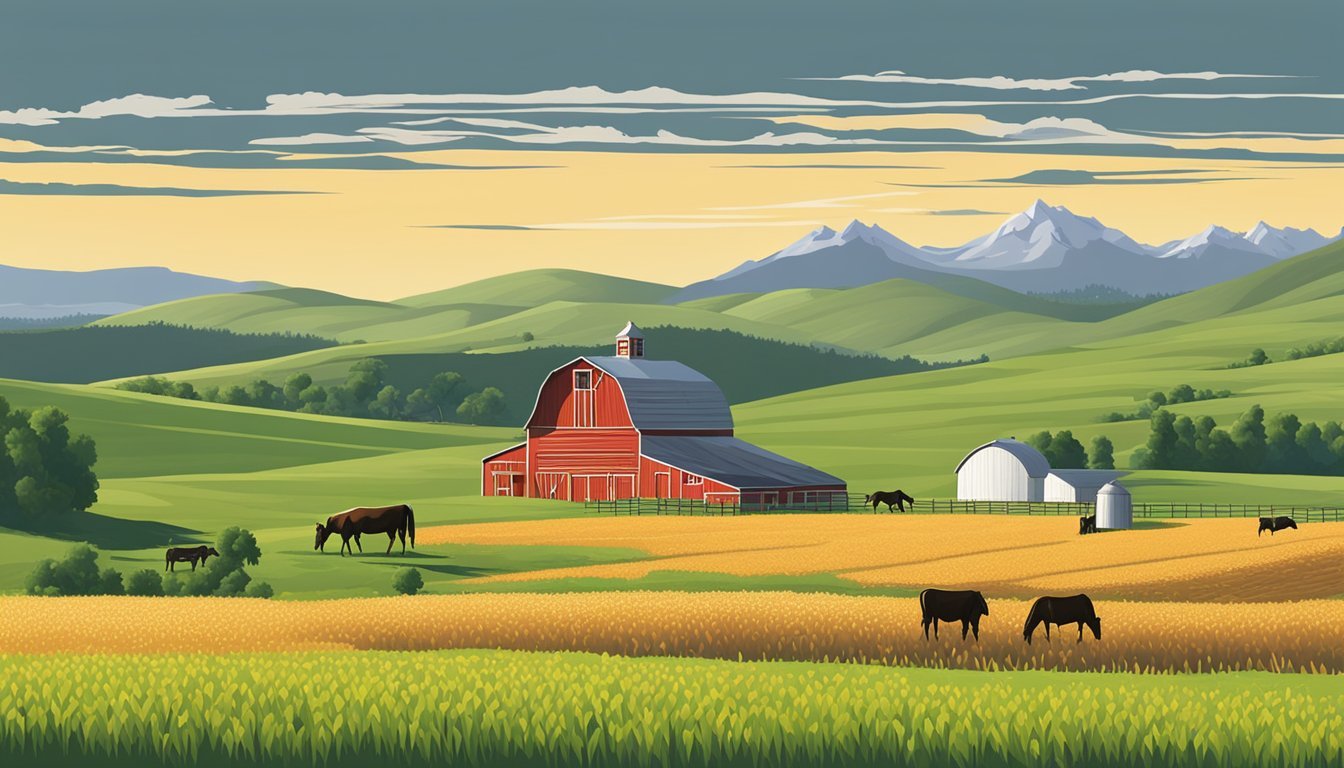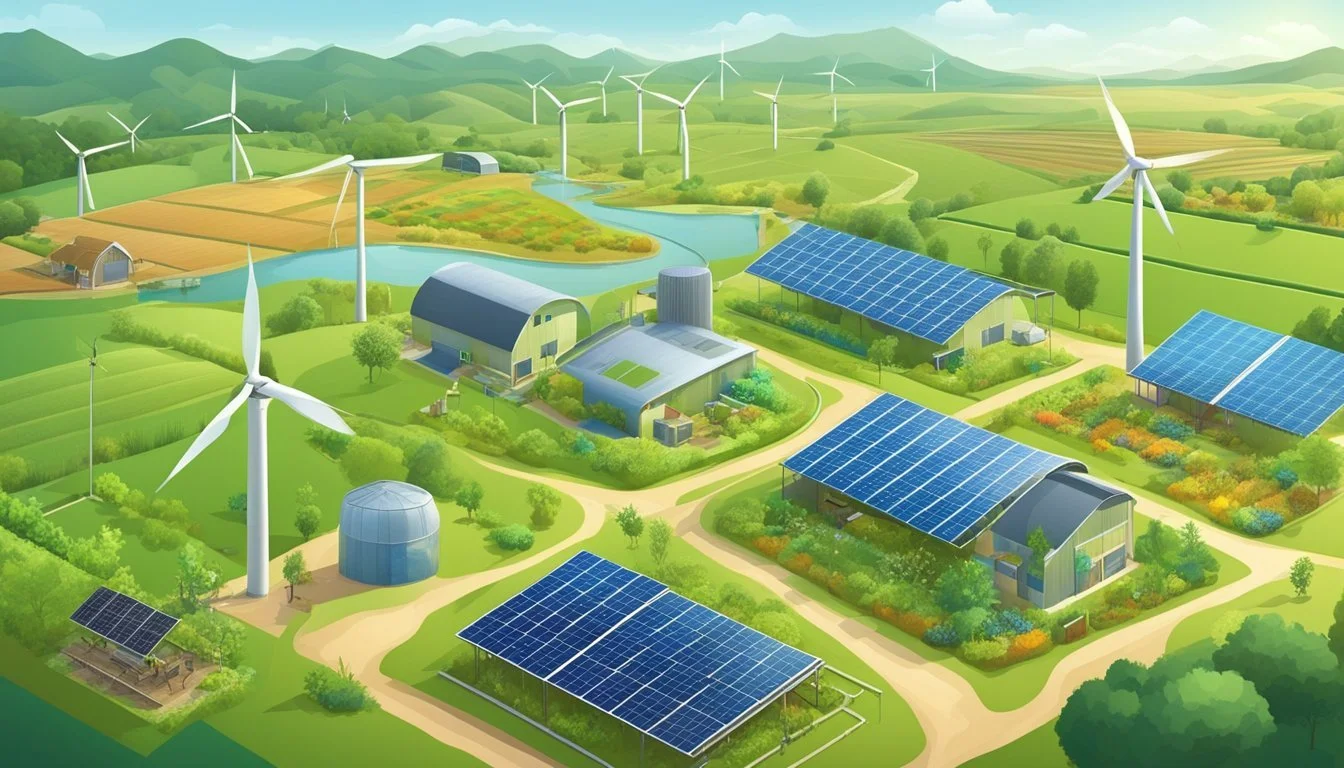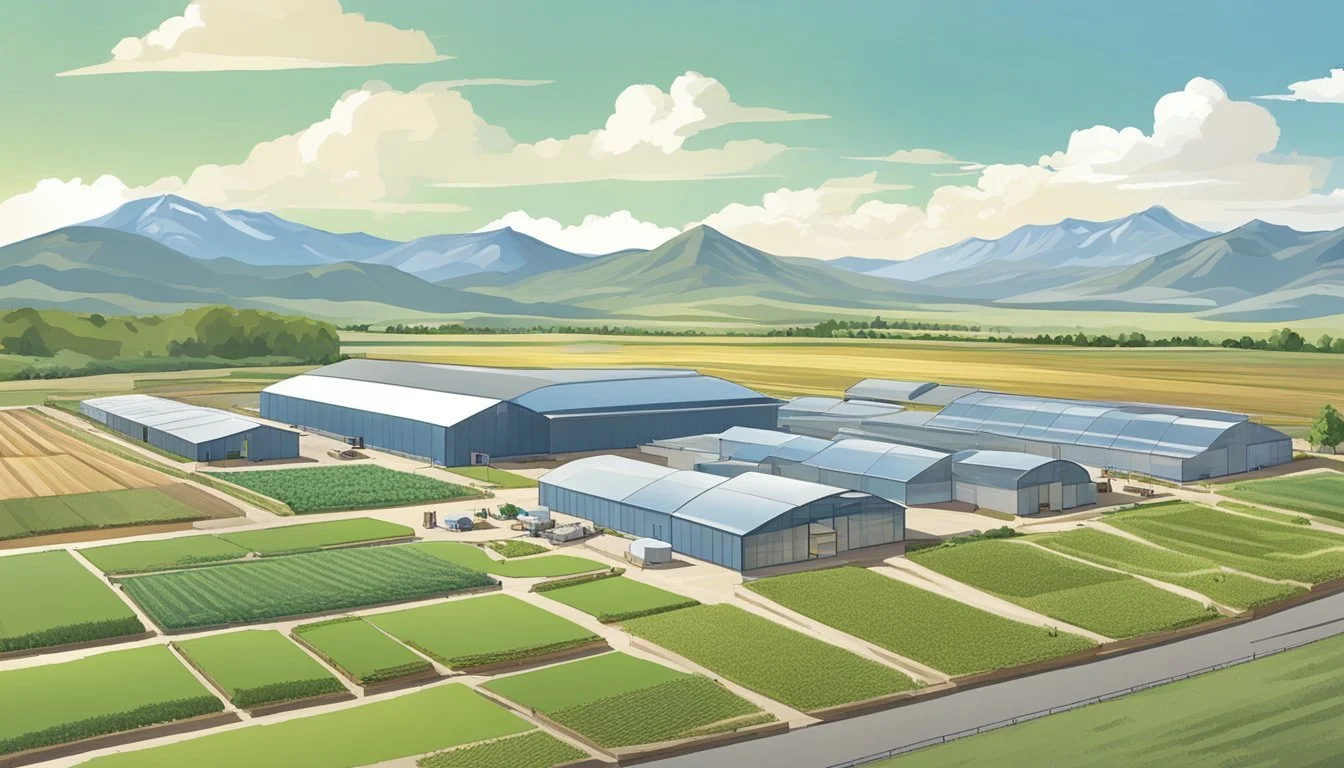Farming Communities in Colorado
Sustainable Practices and Growth
Colorado, with its expansive 66.33 million acres, is a state rich in agricultural diversity. From the vast plains to the Western Slope and the mountainous regions, farming communities across Colorado thrive on their unique landscapes and micro-climates, each contributing significantly to the state's agricultural output. Farmers and ranchers in Colorado take pride in raising cattle, growing crops, and maintaining the land that sustains their livelihoods.
The plains are particularly known for their large-scale cattle ranching and grain production. Meanwhile, the Western Slope boasts a variety of fruit orchards and vineyards, benefiting from the region’s favorable climate. The mountainous areas of Colorado, though rugged, support smaller farming operations that often focus on livestock and specialized crops suited to high altitudes.
These farming communities do not just produce food; they embody the hard-working spirit and resilience of the people who call Colorado home. The agriculture sector plays a vital role in the local economy, supporting a wide array of businesses and contributing to the state's cultural heritage.
History of Agriculture in Colorado
Colorado's agricultural history is rich and diverse, shaped by the state's unique geographical challenges and opportunities. Farmers developed innovative practices, from irrigation to ranching, which have influenced the region's economy and culture.
Early Farming Practices and Settlements
Early human settlements in Colorado transitioned from nomadic lifestyles to permanent agricultural communities around 12,000 years ago. Indigenous peoples played a crucial role in adapting farming methods to the local environment. They built terraces, dams, and canals to manage water in an area with limited precipitation. The Homestead Act of 1862 further accelerated farming, as settlers acquired and cultivated land, establishing permanent homes and farms.
By the early 1900s, farming communities grew as settlers planted crops and developed farming infrastructure. Sugar beets became an important crop, and Colorado grew to become a leading producer of sugar with 17 sugar factories by 1926. The adaptation to local conditions was key to the sustainability and growth of early farming settlements.
Development of Irrigation Systems
Irrigation has been essential for overcoming Colorado's arid climate. Indigenous peoples initiated the first irrigation practices by constructing canals and reservoirs to distribute water across fields. As settlers arrived, they expanded upon these techniques, creating more extensive irrigation systems that included intricate networks of dams and ditches.
Water rights became a significant issue, leading to the establishment of laws regulating the distribution and use of water resources. The necessity of irrigation facilitated the cultivation of various crops, including wheat, corn, and especially sugar beets, which thrived under irrigated conditions. Today, irrigation remains vital, though urban demands for water have led to fields drying up, changing the agricultural landscape once more.
Ranchers and the Cattle Industry
Ranching and cattle have been central to Colorado's agricultural economy since the mid-1800s. Ranchers initially raised cattle on vast open ranges, utilizing the state's extensive grasslands. The introduction of barbed wire in the late 19th century revolutionized the industry by enabling ranchers to fence off their land, thus improving herd management and grazing practices.
Cattle drives were common, with ranchers moving herds to railheads for transport to markets. Additionally, the cattle industry spurred related businesses, including meat processing and leather production. Dairy farming also grew, supplying local communities with milk and cheese. Ranching remains a significant part of Colorado's culture and economy, reflecting the state's enduring connection to its agricultural roots.
Geography and Climate
Colorado's diverse geography creates distinct agricultural regions, each with unique climates that influence farming practices and crop choices. These regions are critical to Colorado's agricultural output and economy.
Plains and Eastern Colorado
The Plains cover the eastern third of Colorado, characterized by vast, open areas ideal for extensive farming and ranching. The region experiences a semi-arid climate, with hot summers and cold winters. Corn, wheat, and sorghum are among the most common crops, thriving despite the region's sporadic rainfall.
Farmers often practice dryland farming, relying on natural precipitation. Irrigation systems are also crucial due to frequent droughts. Cattle ranching is significant here, with large herds grazing on the native grasses. Water management remains a vital issue to address the challenges posed by the semi-arid environment.
Rocky Mountains and Western Slope
The Rocky Mountains and Western Slope offer a contrasting landscape with higher elevations and more varied terrain. This area boasts cooler temperatures and more precipitation compared to the plains. Fruit orchards, vineyards, and specialty crops like peaches, apples, and grapes flourish here.
Sudden weather changes influence growing seasons, necessitating adaptive farming practices. Irrigation from mountain streams and rivers supports agriculture, aiding in crop sustainability. The region is also known for beef and dairy farming, leveraging the natural grasslands and plentiful water sources. Agricultural activities are carefully managed to protect the fragile mountain ecosystems.
San Luis Valley and Southern Colorado
The San Luis Valley, located in southern Colorado, is a unique high-altitude desert valley. Its elevation results in cooler temperatures, making it suitable for potatoes, barley, and alfalfa. Despite its dry climate, the valley benefits from extensive irrigation using water from the Rio Grande and underground aquifers.
The valley's high altitude and cold nights reduce pest issues, contributing to higher-quality produce. Drought is a significant concern, pushing farmers to adopt efficient water usage and conservation strategies.
Farming in this region often includes livestock, particularly cattle and sheep, which are well-suited to the rugged terrain. The combination of altitude, climate, and irrigation creates a distinctive agricultural environment unique to Colorado.
Key Crops and Livestock
Colorado's diverse agricultural landscape includes significant production of grains, specialty crops like peaches and potatoes, and extensive livestock rearing, including cattle and dairy farms. This section outlines the primary agricultural commodities that define Colorado’s farming communities.
Corn, Wheat, and Grains Production
In Colorado, corn and wheat are among the primary grains cultivated. Corn, often grown for both livestock feed and industrial uses, covers large expanses of farmland. Wheat, particularly winter wheat, is another staple, critical for both domestic consumption and export.
Barley and oats are also significant, especially in regions suited to these crops. The harvest cycles for these grains vary, with corn typically harvested in late summer and early fall, while wheat harvest usually takes place in early summer. These grains are essential in sustaining both local and national food systems.
Specialty Crops: Peaches and Potatoes
Colorado is renowned for its high-quality specialty crops, especially peaches and potatoes. The fertile soils of the Western Slope provide an ideal environment for peach orchards. Known for their sweetness, Palisade peaches are highly sought after in markets.
Potatoes are primarily grown in the San Luis Valley, known for its favorable climate and rich soil. This region supports a robust potato farming industry, producing various types that cater to both local and export needs. These specialty crops not only support local economies but also contribute to Colorado's agricultural identity.
Livestock Rearing and Dairy Farms
Livestock farming, particularly cattle rearing, plays a significant role in Colorado’s agriculture. The state’s plains are home to vast cattle ranches, supporting both beef and dairy production. Beef cattle are a major commodity, with large herds maintained across extensive ranchlands.
In addition to cattle, sheep farming is prevalent, particularly for wool and meat. Dairy farms are also crucial, producing significant quantities of milk and cream. These farms employ advanced technologies to ensure efficient and sustainable dairy production, bolstering the state’s agricultural output.
Community Supported Agriculture (CSA) and Farmers' Markets
In Colorado, Community Supported Agriculture (CSA) and farmers' markets play critical roles in connecting consumers to local farms, promoting fresh, seasonal produce, and supporting the farm-to-table movement.
Understanding CSA Models
Community Supported Agriculture (CSA) models represent a partnership between consumers and local farmers. Consumers purchase shares in the farm at the beginning of the growing season. In return, they receive regular deliveries of produce.
CSAs help farmers secure upfront capital, reducing financial risks. For consumers, CSAs offer fresh, seasonal produce while fostering a connection to the source of their food. More than just vegetables, some CSAs include meat, dairy, and eggs, enhancing food variety and quality for members.
The Role of Farmers' Markets
Farmers' markets in Colorado serve as vibrant hubs where local farmers sell their produce directly to consumers. These markets provide an important revenue stream for small farms and offer consumers access to fresh and locally-grown food.
Farmers' markets often feature seasonal produce, artisanal products, and organic options. They also foster community engagement by providing a space for people to meet, socialize, and learn more about local agriculture. The presence of a farmers' market can significantly boost the local economy by keeping food dollars within the community.
Farm-to-Table Movement
The farm-to-table movement emphasizes sourcing food directly from local farms to tables in homes and restaurants. This movement supports sustainable agriculture, reduces food miles, and promotes the consumption of fresh, seasonal, and nutrient-dense foods.
Farm-to-table initiatives strengthen relationships between farms and the local community. Restaurants that adopt this model often highlight local ingredients on their menus, attracting diners who prioritize sustainability and quality. This movement bolsters the local economy and encourages agricultural diversity and resilience.
Sustainability and Conservation Efforts
Colorado farming communities are actively engaged in sustainable practices and conservation initiatives. Efforts include managing water scarcity, improving soil health, promoting regenerative agriculture, and preserving wildlife habitats.
Water Resources and Conservation
Water scarcity is a significant concern for Colorado farmers. Drip irrigation, rainwater harvesting, and efficient water management practices are essential for conserving this vital resource. The Colorado Farm & Food Alliance works to protect water quality and secure a reliable supply for farms.
Sustainable farming methods reduce water usage and mitigate risks associated with droughts. Local advocacy groups promote the adoption of innovative irrigation techniques to ensure the long-term viability of agriculture in the region.
Soil Health and Land Management
Maintaining soil health is crucial for sustainable agriculture in Colorado. Techniques such as crop rotation, cover cropping, and the use of organic fertilizers enhance soil fertility. These practices reduce erosion and prevent nutrient depletion.
No-till farming is another important method. By leaving crop residues on the field, farmers minimize soil disturbance, which improves water retention and fosters beneficial soil microorganisms. These practices support both productivity and environmental health.
Regenerative Agriculture Practices
Regenerative agriculture focuses on revitalizing soil and ecological systems. Practices like composting, silvopasture, and integration of perennial crops enhance farm resilience. These methods increase biodiversity and carbon sequestration in the soil.
Programs supported by Keep It Colorado encourage farmers to adopt regenerative techniques. By restoring soil health and enhancing land productivity, these practices contribute to a more sustainable and resilient farming system.
Wildlife Biodiversity and Habitat Preservation
Preserving wildlife habitats is a key aspect of Colorado's agricultural sustainability. Efforts include creating buffer zones around farmlands and protecting natural areas to support biodiversity.
Organizations like Keep It Colorado are active in initiatives to conserve private lands. Their goal is to double the number of protected acres, ensuring that wildlife can thrive alongside agricultural activities. These conservation efforts benefit both the environment and the farming communities.
Challenges Facing Colorado Farmers
Farmers in Colorado face a multitude of challenges, ranging from economic pressures to climate-driven impacts and complex water management issues. These challenges are interwoven, with each exacerbating the other, making it crucial for farmers to navigate these issues effectively.
Economic and Market Pressures
Economic challenges are prominent for Colorado farmers. Fluctuating commodity prices can make it difficult for farmers to predict their income. Rising costs of inputs such as seeds, fertilizers, and equipment also strain their budgets.
Additionally, market access and competition can limit profitability. Farmers often find themselves competing with both local and global markets, impacting their ability to sell crops at sustainable prices.
This economic instability forces many farming operations to carefully manage their financial resources, seeking ways to reduce costs and increase efficiency to stay viable.
Climate Change Impacts and Adaptation
Climate change has profound effects on agriculture in Colorado. Increased temperatures lead to more heat stress on crops and livestock, reducing yields and productivity. The state’s dairy cows have shown decreases in milk production and fertility due to rising temperatures.
Rural communities are particularly vulnerable to these changes. Frequent droughts further compound the issue, leading to water scarcity and crop failures. Farmers must adopt new strategies to adapt, such as selecting drought-resistant crops and altering planting schedules.
Efforts to mitigate these impacts include implementing advanced irrigation technologies and participating in carbon sequestration programs.
Water Management and Rights Issues
Water management is a critical issue for Colorado farmers, with water rights being a complex and contentious topic. The state’s arid climate and periodic droughts exacerbate water shortages, making efficient water use essential.
Farmers must navigate a web of water rights laws to secure sufficient water for irrigation. The Colorado Water Conservation Board and other regulatory bodies set strict guidelines for water usage to ensure sustainable practices.
Innovations in water-saving technologies, such as drip irrigation and soil moisture sensors, are being adopted. Moreover, collaborative efforts among farmers, conservationists, and policymakers aim to balance agricultural needs with environmental requirements.
These strategies are essential in maintaining the delicate balance between water resource conservation and agricultural productivity.
Agricultural Education and Research
Agriculture in Colorado benefits significantly from diverse educational programs and cutting-edge research initiatives. These resources support sustainable practices and drive economic growth.
Agricultural Programs in Schools and Universities
Colorado State University (CSU) is a major player in agricultural education. With facilities such as the Agricultural Research, Development and Education Center (ARDEC) and the CoBank Center for Ag Education, CSU offers programs for teaching courses, judging classes, and hosting events. Their research focuses on soil carbon, climate change solutions, and optimizing food system productivity. These efforts support U.S. policy through substantial climate-smart agriculture programs.
Colorado's K-12 schools also integrate agriculture into their curriculum, supported by the Colorado Foundation for Agriculture. Educational grants and workshops enhance students' understanding of local farming practices. Vocational schools provide hands-on training in animal husbandry, crop management, and sustainable farming techniques.
Nonprofit Organizations and Extension Services
Nonprofit organizations in Denver and throughout Colorado play a critical role in agricultural research and education. These organizations offer workshops, grants, and resources for local farmers. The Colorado Agriculture Extension Service, for instance, provides research-based information and training to producers in various regions.
Nonprofits like the Rocky Mountain Farmers Union advocate for farmers' rights and sustainable agriculture practices. They offer educational programs in collaboration with universities and community organizations. Extension services assist with urban farming, pest management, and economic development in farming communities, addressing specific regional needs.
These collaborative efforts between educational institutions, nonprofits, and extension services ensure that Colorado's agricultural industry remains innovative and resilient.
Innovations in Colorado Agriculture
Colorado is a hub for agricultural innovation, integrating modern technology with traditional farming practices to enhance productivity and sustainability. Key areas of innovation include urban agriculture, renewable energy integration, and advanced farming techniques.
Urban Agriculture and Community Gardens
Urban agriculture is gaining traction across Colorado. In cities like Denver, vacant lots and roofs are transformed into community gardens. These initiatives provide local produce, reduce food deserts, and foster community engagement. Techniques such as vertical farming allow urban farmers to maximize space and yield.
Programs and non-profits support urban growers with resources like soil testing and seed grants. Emerging technologies, including hydroponics and aquaponics, are also used to grow crops in non-traditional environments, highlighting a shift towards sustainable urban practices.
Agrivoltaics and Renewable Energy on Farms
Agrivoltaics combines solar power with agriculture, allowing crops to grow beneath solar panels. This dual-use of land maximizes output and provides a secondary income stream for farmers. Colorado's sunny climate is ideal for this innovation, making it a leading state in agrivoltaics implementation.
Farmers benefit from reduced water usage as the panels provide shade, which lowers evaporation rates. Additionally, renewable energy installations can power farm operations, cutting down on fossil fuel dependence and lowering carbon footprints. Grants and subsidies from state and federal programs further encourage adoption.
Advancements in Crop Production and Farming Practices
Technological advancements are revolutionizing traditional farming. Precision agriculture tools, such as GPS mapping and drones, enable farmers to monitor crop health and optimize field management. These innovations lead to higher yields and lower resource use.
Genetic modification and improved crop varieties resistant to pests and harsh weather conditions are also significant. Automated machinery reduces labor costs and increases efficiency. Moreover, sustainable farming practices like crop rotation and soil conservation are being enhanced through data analytics, ensuring healthier soil and better crop performance.
Colorado's commitment to agriculture innovation sustains its farming communities, making them resilient and more productive.
Local and Global Impact
Farming communities in Colorado play a crucial role in both local economies and broader global markets. They support regional food security while also contributing significantly to international agricultural trade.
Export of Agricultural Products
Colorado's agricultural sector is a key player in the global market. Products such as beef, wheat, and dairy are major exports. These commodities reach numerous countries, fostering international trade relationships.
Beef is particularly notable, as Colorado's ranching heritage ensures high-quality livestock production. Wheat and dairy products also hold prominent positions, driven by the state's extensive farming infrastructure.
Major Export Commodities:
Beef
Wheat
Dairy
Colorado's participation in global markets also brings economic benefits to the state, boosting local businesses and providing employment opportunities.
Contributions to Food Access and Security
Locally, Colorado's farms enhance food access and security. Efforts by county programs and universities help bridge the gap between producers and consumers. For instance, Boulder County’s investment in sustainable farming has made local produce more accessible.
Key Initiatives:
Community-supported agriculture (CSA) programs
Farmers' markets
Extension services by Colorado State University
These programs ensure fresh produce is available widely, supporting nutrition and food security. They also strengthen local economies by encouraging the consumption of locally grown food. Access to fresh, local produce improves dietary options for residents, particularly in rural areas.
Culinary Culture and Agrotourism
Colorado's farming communities offer a rich tapestry of culinary experiences and agrotourism activities. Visitors can enjoy farm-to-table dining, participate in culinary tours, and explore various agritourism opportunities across the state.
Farm-to-Table Restaurants and Culinary Tours
Colorado boasts numerous farm-to-table restaurants that highlight local produce and meats. In Vail, restaurants offer menus that change seasonally to ensure the freshest ingredients. These establishments often have strong relationships with nearby farms, ensuring that dishes feature the best of local agriculture.
Culinary tours provide another layer of engagement. Participants can visit farms, sample fresh products, and enjoy meals prepared on-site. Rocky Ford, known for its melons, often features in such tours, giving visitors a taste of the region's prized produce.
Agrotourism Opportunities in Farming Communities
Agrotourism in Colorado offers visitors a chance to engage directly with the state's agricultural roots. Activities range from vineyard tours in Palisade to cattle ranch visits in the plains. Stone Cottage Cellars in Paonia is notable for its picturesque vineyard and stone cottage stays, allowing for an immersive rural experience.
Cultural events hosted by farms include festivals, harvest celebrations, and craft fairs that showcase local history and traditions. These events not only provide fun and education but also support the local agricultural economy.
Agrotourism helps to educate the public about farming practices and the importance of agriculture to Colorado's heritage. By participating, visitors gain a deeper appreciation for the state's agricultural diversity and the hard work of its farming communities.
Future of Farming in Colorado
The future of farming in Colorado is shaped by advancements in technology, evolving policy and legislation, and the influence of young farmers starting new ventures. Significant changes are imminent as these elements interact and redefine agriculture in the region.
Technological Advances and Smart Farming
Technological integration in agriculture is transforming traditional farming practices in Colorado. Smart farming techniques, such as precision agriculture and automated machinery, ensure efficient use of resources like water and fertilizers.
Drones and sensor technologies are increasingly used to monitor crop health and soil conditions. Farmers benefit from real-time data, enabling informed decisions that maximize yield and minimize environmental impact.
Additionally, advancements in genetic engineering allow for the development of drought-resistant crops, crucial for a state often facing water shortages. These innovations are essential for sustainable farming as they reduce dependency on natural resources and enhance productivity.
Policy and Legislation Trends
Policies and legislation significantly influence the agricultural landscape in Colorado. Recent legislative efforts focus on sustainable farming practices and support for small and medium-sized farms.
Proposals addressing climate change impact are at the forefront, emphasizing reduced greenhouse gas emissions and improved soil health. Subsidies and grants are increasingly available for farmers adopting eco-friendly practices.
Colorado’s agricultural policies also aim to promote local food systems, ensuring that communities have access to fresh, locally grown produce. Efforts in policy reform reflect a commitment to adaptability and resilience in the farming sector.
Young Farmers and New Farm Startups
A new generation of young farmers is emerging, bringing innovative approaches to Colorado’s agricultural scene. These young entrepreneurs often use methods like permaculture and organic farming, which are gaining popularity.
They leverage community-supported agriculture (CSA) models to connect directly with consumers. Establishing new farm startups, these farmers are reviving abandoned lands and transforming them into productive agriculturally zones.
Educational institutions and programs like those from Colorado State University are vital, offering essential skills and knowledge to budding farmers. This young, dynamic cohort is crucial for the continuous evolution and sustainability of agriculture in Colorado.









